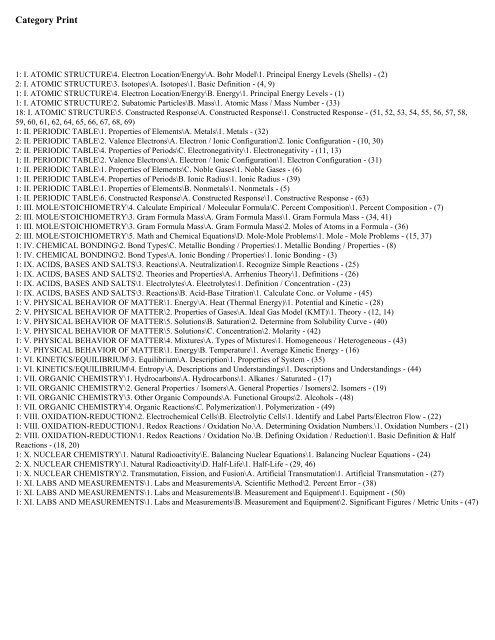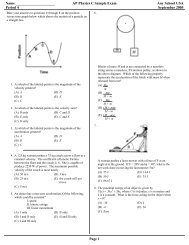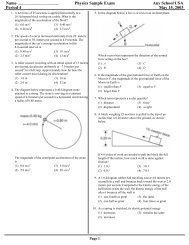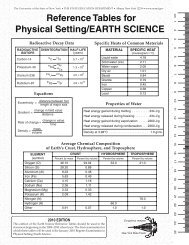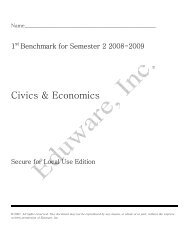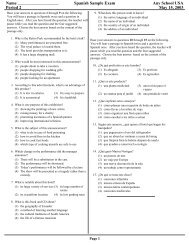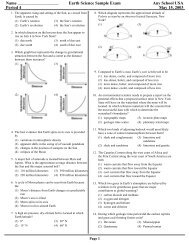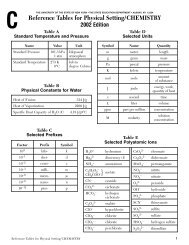NYS Regents Chemistry June 21, 2002 - Eduware
NYS Regents Chemistry June 21, 2002 - Eduware
NYS Regents Chemistry June 21, 2002 - Eduware
You also want an ePaper? Increase the reach of your titles
YUMPU automatically turns print PDFs into web optimized ePapers that Google loves.
Category Print<br />
1: I. ATOMIC STRUCTURE\4. Electron Location/Energy\A. Bohr Model\1. Principal Energy Levels (Shells) - (2)<br />
2: I. ATOMIC STRUCTURE\3. Isotopes\A. Isotopes\1. Basic Definition - (4, 9)<br />
1: I. ATOMIC STRUCTURE\4. Electron Location/Energy\B. Energy\1. Principal Energy Levels - (1)<br />
1: I. ATOMIC STRUCTURE\2. Subatomic Particles\B. Mass\1. Atomic Mass / Mass Number - (33)<br />
18: I. ATOMIC STRUCTURE\5. Constructed Response\A. Constructed Response\1. Constructed Response - (51, 52, 53, 54, 55, 56, 57, 58,<br />
59, 60, 61, 62, 64, 65, 66, 67, 68, 69)<br />
1: II. PERIODIC TABLE\1. Properties of Elements\A. Metals\1. Metals - (32)<br />
2: II. PERIODIC TABLE\2. Valence Electrons\A. Electron / Ionic Configuration\2. Ionic Configuration - (10, 30)<br />
2: II. PERIODIC TABLE\4. Properties of Periods\C. Electronegativity\1. Electronegativity - (11, 13)<br />
1: II. PERIODIC TABLE\2. Valence Electrons\A. Electron / Ionic Configuration\1. Electron Configuration - (31)<br />
1: II. PERIODIC TABLE\1. Properties of Elements\C. Noble Gases\1. Noble Gases - (6)<br />
1: II. PERIODIC TABLE\4. Properties of Periods\B. Ionic Radius\1. Ionic Radius - (39)<br />
1: II. PERIODIC TABLE\1. Properties of Elements\B. Nonmetals\1. Nonmetals - (5)<br />
1: II. PERIODIC TABLE\6. Constructed Response\A. Constructed Response\1. Constructive Response - (63)<br />
1: III. MOLE/STOICHIOMETRY\4. Calculate Empirical / Molecular Formula\C. Percent Composition\1. Percent Composition - (7)<br />
2: III. MOLE/STOICHIOMETRY\3. Gram Formula Mass\A. Gram Formula Mass\1. Gram Formula Mass - (34, 41)<br />
1: III. MOLE/STOICHIOMETRY\3. Gram Formula Mass\A. Gram Formula Mass\2. Moles of Atoms in a Formula - (36)<br />
2: III. MOLE/STOICHIOMETRY\5. Math and Chemical Equations\D. Mole-Mole Problems\1. Mole - Mole Problems - (15, 37)<br />
1: IV. CHEMICAL BONDING\2. Bond Types\C. Metallic Bonding / Properties\1. Metallic Bonding / Properties - (8)<br />
1: IV. CHEMICAL BONDING\2. Bond Types\A. Ionic Bonding / Properties\1. Ionic Bonding - (3)<br />
1: IX. ACIDS, BASES AND SALTS\3. Reactions\A. Neutralization\1. Recognize Simple Reactions - (25)<br />
1: IX. ACIDS, BASES AND SALTS\2. Theories and Properties\A. Arrhenius Theory\1. Definitions - (26)<br />
1: IX. ACIDS, BASES AND SALTS\1. Electrolytes\A. Electrolytes\1. Definition / Concentration - (23)<br />
1: IX. ACIDS, BASES AND SALTS\3. Reactions\B. Acid-Base Titration\1. Calculate Conc. or Volume - (45)<br />
1: V. PHYSICAL BEHAVIOR OF MATTER\1. Energy\A. Heat (Thermal Energy)\1. Potential and Kinetic - (28)<br />
2: V. PHYSICAL BEHAVIOR OF MATTER\2. Properties of Gases\A. Ideal Gas Model (KMT)\1. Theory - (12, 14)<br />
1: V. PHYSICAL BEHAVIOR OF MATTER\5. Solutions\B. Saturation\2. Determine from Solubility Curve - (40)<br />
1: V. PHYSICAL BEHAVIOR OF MATTER\5. Solutions\C. Concentration\2. Molarity - (42)<br />
1: V. PHYSICAL BEHAVIOR OF MATTER\4. Mixtures\A. Types of Mixtures\1. Homogeneous / Heterogeneous - (43)<br />
1: V. PHYSICAL BEHAVIOR OF MATTER\1. Energy\B. Temperature\1. Average Kinetic Energy - (16)<br />
1: VI. KINETICS/EQUILIBRIUM\3. Equilibrium\A. Description\1. Properties of System - (35)<br />
1: VI. KINETICS/EQUILIBRIUM\4. Entropy\A. Descriptions and Understandings\1. Descriptions and Understandings - (44)<br />
1: VII. ORGANIC CHEMISTRY\1. Hydrocarbons\A. Hydrocarbons\1. Alkanes / Saturated - (17)<br />
1: VII. ORGANIC CHEMISTRY\2. General Properties / Isomers\A. General Properties / Isomers\2. Isomers - (19)<br />
1: VII. ORGANIC CHEMISTRY\3. Other Organic Compounds\A. Functional Groups\2. Alcohols - (48)<br />
1: VII. ORGANIC CHEMISTRY\4. Organic Reactions\C. Polymerization\1. Polymerization - (49)<br />
1: VIII. OXIDATION-REDUCTION\2. Electrochemical Cells\B. Electrolytic Cells\1. Identify and Label Parts/Electron Flow - (22)<br />
1: VIII. OXIDATION-REDUCTION\1. Redox Reactions / Oxidation No.\A. Determining Oxidation Numbers.\1. Oxidation Numbers - (<strong>21</strong>)<br />
2: VIII. OXIDATION-REDUCTION\1. Redox Reactions / Oxidation No.\B. Defining Oxidation / Reduction\1. Basic Definition & Half<br />
Reactions - (18, 20)<br />
1: X. NUCLEAR CHEMISTRY\1. Natural Radioactivity\E. Balancing Nuclear Equations\1. Balancing Nuclear Equations - (24)<br />
2: X. NUCLEAR CHEMISTRY\1. Natural Radioactivity\D. Half-Life\1. Half-Life - (29, 46)<br />
1: X. NUCLEAR CHEMISTRY\2. Transmutation, Fission, and Fusion\A. Artificial Transmutation\1. Artificial Transmutation - (27)<br />
1: XI. LABS AND MEASUREMENTS\1. Labs and Measurements\A. Scientific Method\2. Percent Error - (38)<br />
1: XI. LABS AND MEASUREMENTS\1. Labs and Measurements\B. Measurement and Equipment\1. Equipment - (50)<br />
1: XI. LABS AND MEASUREMENTS\1. Labs and Measurements\B. Measurement and Equipment\2. Significant Figures / Metric Units - (47)


